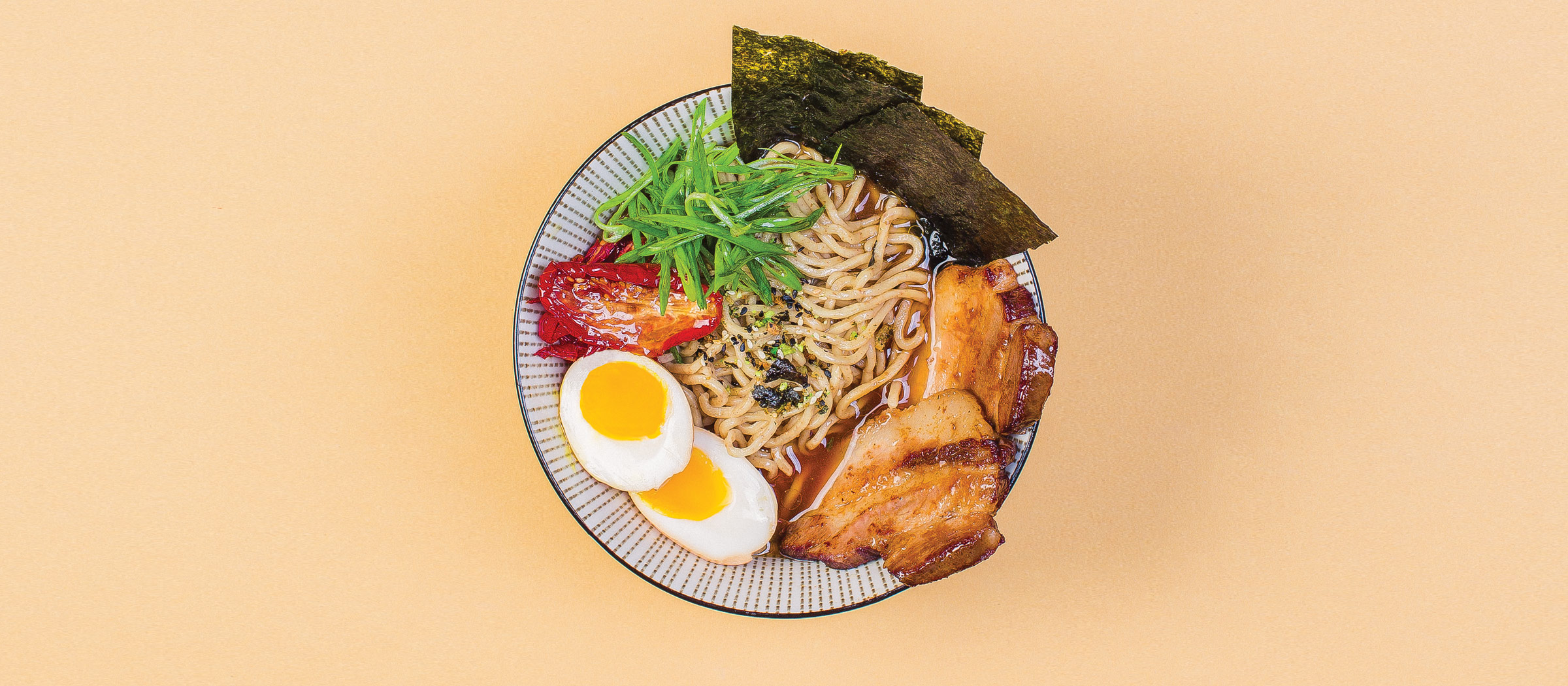The New Gastronome
Freaky Ramen
Freaky Pairings Episode II: The Mighty Ramen
by Good Mood Food Club
by Good Mood Food Club

Many may say, “ramen is like a stage”, meaning you can give your play endless interpretations. Our ramen is a “double broth”, meaning we do a very slow-cooked chicken-pork broth and combine it with dashi broth in a 50/50 ratio.
As for the noodles, we make them with white flour, Semola, Rye flour and salt with baked baking soda and water. Toppings may vary from dried tomatoes to fried cauliflower and many more. In our ramen, you will always find roasted pork belly, a marinated egg, Nori seaweed and scallions.
A. D. V. E. R. T. I. S. I. N. G.

Hubert et Heidi Hausherr is a 3.9 ha independent and biodynamic wine producer from Alsace. He works in accordance with the rhythms and rules of nature, without the implementation of chemicals, to respect his land, his grapes, and his wine. We chose COPAINS COMME RAISINS 2017 for this pairing because of its natural freshness and medium-light body that merges perfectly with the roundness and umaminess of the ramen. The grape varieties are a blend of the classical grapes from Alsace such as Riesling, Pinot Gris, Gewürztraminer, Sylvaner and Auxerrois that are spontaneously fermented and stay in skin contact, for three weeks. In the end, it is bottled with no filtration and no added sulfur dioxide.

Recipe
Let’s say you’ve got all your ramen components prepped and ready, lined up on the counter. The chashu’s warm, the soup is simmering on the stove. Appropriate ladles are matched to their respective sauces. From here, assembling a bowl of ramen is a cinch. (We know, we know, you’ve spent a week sourcing ingredients, boiling chickens, rendering fat, and braising chashu. Now, you know how we feel when we make ramen for other people’s’ enjoyment).
| Warm Chicken Fat | 10 ml (2 tsp) |
| Warm Pork Fat | 10 ml (2tsp) |
| Room-temperature Shio Tare | 30 ml (3 tbsp) |
| Double Soup, simmering | 270 ml |
| Rye Noodles | 130g |
| Fermented Turnip | 30g |
| Pork Belly Chashu * | 1 thick slice |
| Half-cooked Egg, room-temperature | 1 |
| Finely shredded Greens for garnishing |
Homemade furikake: nori, fried onion, sesame, wasabi
* warmed in its cooking liquid or in the noodle water as it comes to a simmer
If you’re not yet ready to assemble, here is how you get there:
Step 1: Chicken Fat
Use chicken skin trimmings, over low heat, until completely rendered. Strain and cool down to room temperature.
Step 2: Pork Fat
Render pork fat trimmings, over low heat, until completely rendered. Strain and cool down to room temperature.
Step 3: Shio Tare
| Fuji Apple, diced | 300g |
| Onion, diced | 1,2 kg |
| Garlic, thinly chopped | 160g |
| Fresh Ginger, thinly chopped | 100g |
| Vegetable Oil | 1l |
Mix everything together in a shallow pan and cook very gently, over low heat for a few hours, or until lightly brown. Make sure to obtain a uniform paste (like a sofrito). Cool down and refrigerate.
Step 4: Double Soup
| Chicken Stock (use favourite recipe) | 500g |
| Dashi, use the following: | 500g |
| Soft water | 500g |
| Kombu | 30g |
| Katsuobushi | 30g |
For the chicken stock, use the same amount of water as chicken carcass to try and clean off all the impurities, make sure to use water without a large amount of chlorine.
For the dashi, add kombu to cold water and bring it to 80 °C and keep it at this temperature for at least 15-20 minutes. It is very important that you don’t get to the boiling point! Strain the kombu and add the katsuobushi flakes to the warm broth, leaving it to rest for a couple of minutes and strain from the katsuobushi. You can adjust the amount of kombu and katsuobushi according to your personal taste. Dried shiitake mushroom can be a nice addition to your broth.
Step 5: Rye Noodles
| Rye flour; can eventually be toasted | 75g |
| High-gluten bread flour | 620g |
| Semola | 300g |
| Cool Water | 430 ml |
| Salt | 13g |
| Baked Baking Soda* or Kansui | 10g |
* baking soda, baked in the oven at 120°C for an hour
The noodles are the core of any nice ramen. This is our recipe, but, you can experiment as much as you want. We suggest you always use some strong bread flour and play a bit with the rest of the amount to create your own flavour. You don’t need a fancy noodle machine to make great noodles. You can also obtain great results with a standard pasta machine; you just have to mix all the ingredients with a lot of energy and leave the dough to rest for about 24 hours before cutting it. If you have the possibility to let it rest in a vacuumed bag, that would be the best option.
Step 6: Fermented Turnip
We have chosen turnip because they are in season (October through March) and because they add a bit of spiciness and crunchiness to our bowl of Ramen. You can choose any vegetable you like according to what’s in season. Dice it nicely; add 2 % salt and leave it to ferment in a jar for a couple of days, or, until it reaches the grade of acidity you like.
Step 7: Pork Belly Chashu
| Sake | 25 ml |
| Mirin | 25 |
| Garlic | 10g |
| Fresh Ginger, coarsely chopped | 20 |
| Dark Soy Sauce | 150g |
| Light Soy Sauce | 75 ml |
| Sugar | 20g |
| Pork Belly* | 1 kg |
| Water as needed |
* free range pork is the tastiest, and the best choice you can make for the environment and for yourself!
Leave the pork belly to marinate overnight and the day after, transfer it into a pan, cover it with water and cook it over low-medium heat for about four hours. When the meat is tender, remove it from the pot and set it on a tray to cool. It is important to cool down the meat before slicing, otherwise, you’ll end up with pulled pork. Reserve the cooking liquid for the marinated eggs.
Step 8: Half-cooked Eggs
This is a fundamental element for a good looking bowl of ramen! It’s very easy, but you have to be careful not to overcook the egg. We found the right cooking time is six minutes and to put it into an ice-bath right after. After peeling, soak the eggs in the reserved chashu marinade for some extra flavor, and to get the nice brown color.
Step 9: Homemade Furikake
It’s definitely the extra boost we like in our bowl of noodles; it’s very easy to make, and you can play a lot with it. This time, we’ve chosen to mix toasted black sesame seeds, dried caramelized onions, nori toasted sheets and wasabi peas. Place all the ingredients in a blender, except for the sesame seeds. Blend it at top speed for a few seconds until it’s coarsely ground. Add the sesame seeds and store in an airtight container.
Step 10: Assemble!
You’ve done it! Go back up to learn how to assemble your bowl of Ramen!
Photos: Aarón Gómez Figueroa | Intro: Constanze Weiss